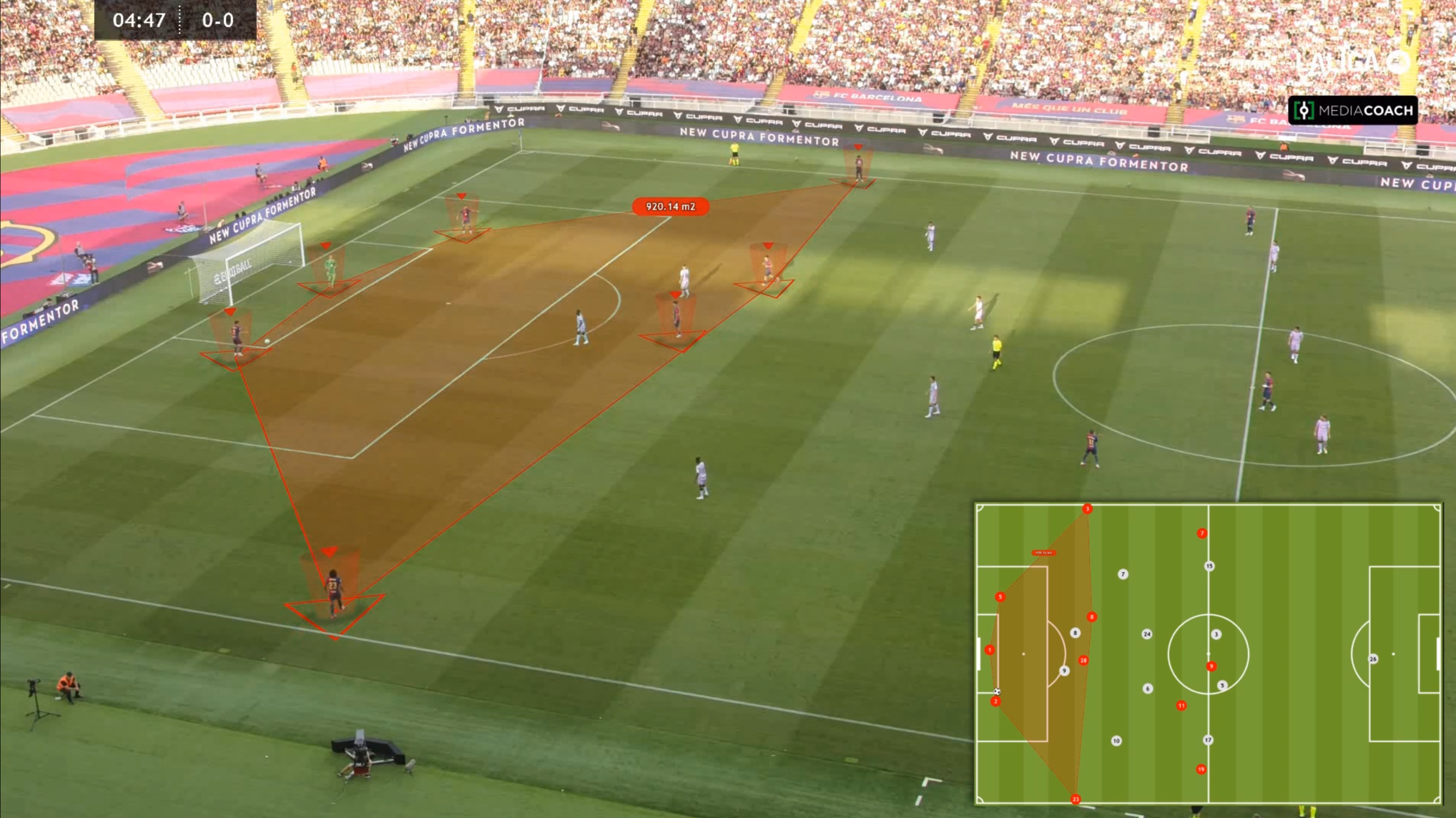
12 Sep Optimizing Goalkeeper Restarts: How Partial Convex Hull Analysis is Revolutionizing Football Tactics
In modern football, goalkeeper restarts in short plays have become a critical part of match strategy, particularly when faced with high pressing from the opposing team. Whether to play short from the back or launch a long ball is no longer just a tactical decision made in the moment, but rather an aspect of the game that’s being increasingly analyzed through advanced data techniques. One of the emerging tools in this analysis is the convex hull, a geometric concept that has been repurposed to measure the area occupied by players on the field.
Traditionally, convex hull analysis has been applied to the entire team, excluding the goalkeeper, to understand how the team occupies and controls space. However, in a recent study conducted by LALIGA, we introduced a novel use of the partial convex hull—focusing specifically on the space occupied by the defensive line, defensively-involved midfielders, and the goalkeeper in short restarts under high pressure. The findings provide actionable insights for coaches aiming to optimize their team’s performance when building play from the back.
What is Partial Convex Hull and Why It Matters?
To understand how convex hulls apply to football, imagine drawing a rubber band around the outermost positions of certain players on the field. The area inside the rubber band is the convex hull. In a typical analysis, this would include all outfield players (excluding the goalkeeper) to analyze how the team controls space. But what if you could zero in on just the players responsible for starting play from the back under pressure? That’s where partial convex hull analysis comes into play.
In our study, we focused on the goalkeeper, the defensive line, and the defensively-involved midfielders. We measured the area these players occupy on the field during short restarts, particularly when the opposing team is applying high pressure. What we discovered is that the larger the area occupied by these players, the less likely the team is to lose possession. This effect holds true regardless of the opponent’s pressing strategy, suggesting that how you manage space is more important than how you are pressed.
Practical Insights for Coaches: Applying Partial Convex Hull to Improve Play
These findings are not just theoretical—they have real implications for the training ground and matchday strategies. Here are some key takeaways for coaches looking to implement these insights into their tactical approach:
1️⃣ Train to Expand the Field
One of the most important lessons from this analysis is that expanding the area occupied by the defensive unit and midfielders during restarts is crucial. A larger area creates more passing lanes, making it harder for the pressing team to block all available options. By training your players to spread out more effectively during short restarts, you give them the space needed to evade pressure and build play from the back.
This doesn’t just apply to defenders—midfielders with defensive responsibilities must learn to position themselves in ways that stretch the opponent’s press. By expanding the convex hull, you maximize the number of passing options available to the goalkeeper and reduce the likelihood of conceding possession in dangerous areas.
2️⃣ Adapt Your Tactical System
Another important finding is that the effectiveness of the convex hull can vary depending on the team’s tactical system. For example, a team playing with a back three might naturally occupy less space than one with a back four, particularly if the midfielders aren’t actively involved in spreading the play.
Given this, one might wonder: Would it be crazy to modify the tactical system only during restarts under high pressure to expand this space and, once the pressure is overcome, revert to the original formation? This is not such a far-fetched idea. By temporarily switching to a formation that increases the convex hull during restarts—such as pushing full-backs wider or having a midfielder drop deeper—you can create more space to bypass the press. Then, once the ball is successfully progressed, the team can return to its original structure.
3️⃣ Positioning is Key
Lastly, intelligent positioning is just as important as the size of the convex hull. It’s not enough to simply occupy a large area—the players must understand how to move within this space to create effective passing lanes and support the ball carrier. This requires training players not just in technical skills but also in spatial awareness. Defenders and midfielders need to be able to read the game, anticipate the press, and adjust their positions dynamically to maximize the convex hull’s effectiveness.
Going Beyond the Numbers: The Future of Tactical Innovation
The partial convex hull is a cutting-edge concept that is just beginning to find its place in football analysis. It offers a deeper understanding of how space is used in critical moments of the game, such as goalkeeper restarts under pressure. While more traditional metrics like possession percentage or passing accuracy give us valuable insights, the use of spatial metrics like convex hull analysis takes the game’s tactical understanding to a new level.
For coaches, the lesson here is clear: to win the battle against high pressing teams, you need to train your players to manage space effectively. Whether this involves expanding the area during restarts, tweaking your tactical system, or improving player positioning, the ultimate goal is to create more passing options and make it harder for the opponent to disrupt your build-up play.
Conclusion: Transforming Goalkeeper Restarts with Convex Hull Analysis
Our study reveals that there is much more to successful goalkeeper restarts than meets the eye. By focusing on the space occupied by the defensive line, defensively-involved midfielders, and the goalkeeper, coaches can significantly reduce the likelihood of losing possession during short restarts under pressure. This novel use of partial convex hull analysis provides a fresh perspective on how teams can better manage space, and it opens the door to new tactical innovations in the game.
The next time you’re preparing for a match against a team known for their high press, remember: it’s not just how they press, it’s how your players use the space that can make all the difference.


